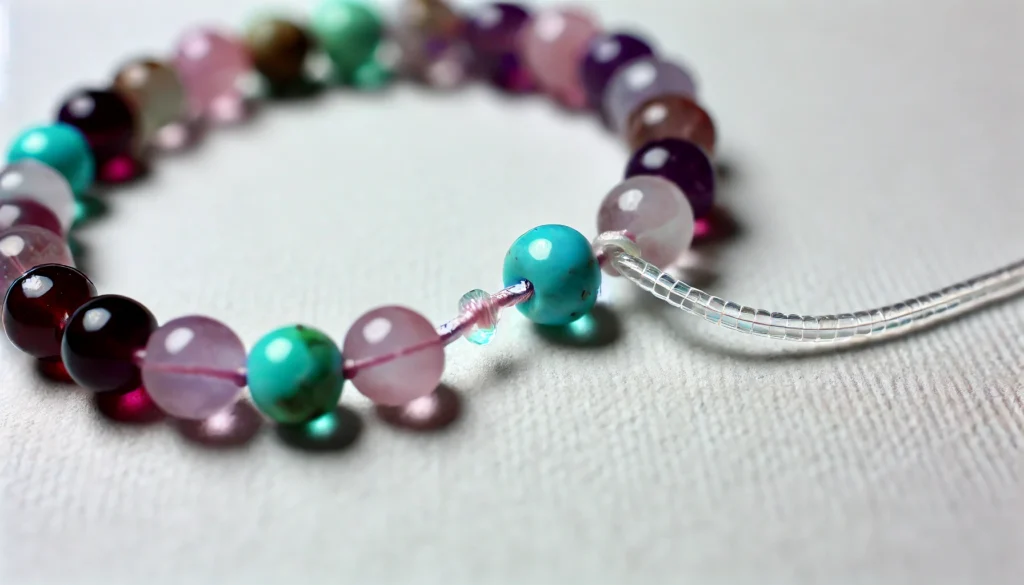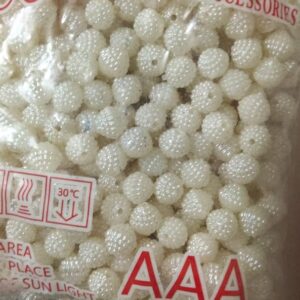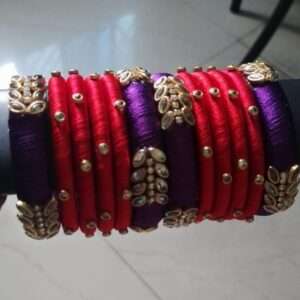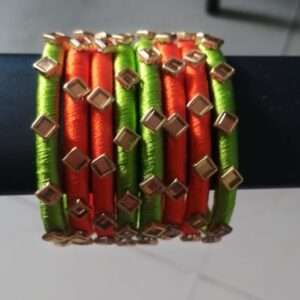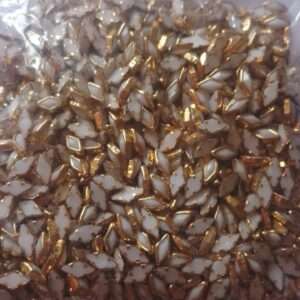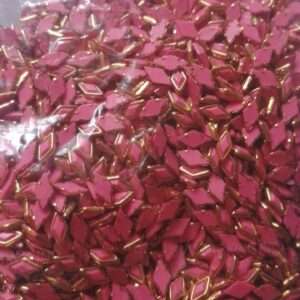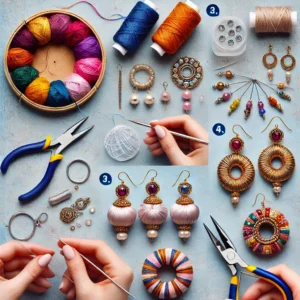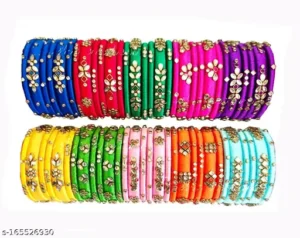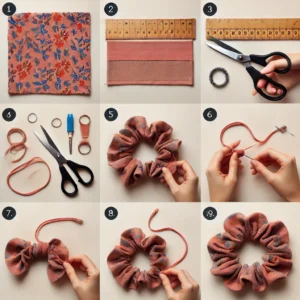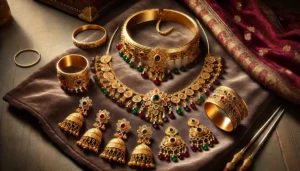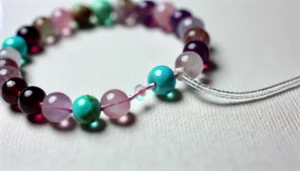Home » Posts tagged '#HandmadeJewelry'
Tag Archives: #HandmadeJewelry
DIY Terracotta Jewelry: Unleash Your Creativity with These Easy Step-by-Step Images!
Learn how to make terracotta jewelry with our step-by-step guide. Discover the materials needed, tips, and tricks to create beautiful, sustainable pieces at home.
Terracotta jewelry, known for its earthy and rustic charm, is becoming a popular choice among DIY enthusiasts and fashion lovers alike. This handcrafted jewelry, made from natural clay, can be customized in endless designs, making it both unique and sustainable. If you’re looking to create your own terracotta jewelry, this guide will take you through the process step-by-step, complete with images to help you craft stunning pieces right at home.
What You Need to Get Started
Before diving into the steps, gather these essential materials:
- Terracotta clay (available in art supply stores)
- Rolling pin or clay roller
- Cookie cutters or any small mold for shaping
- Sandpaper
- Water and sponge
- Paints (acrylic or fabric paints)
- Paintbrushes
- Jewelry findings (hooks, earring posts, chains, etc.)
- Needle or pin for making holes
- Clear varnish or glaze for finishing
Step-by-Step Process to Make Terracotta Jewelry
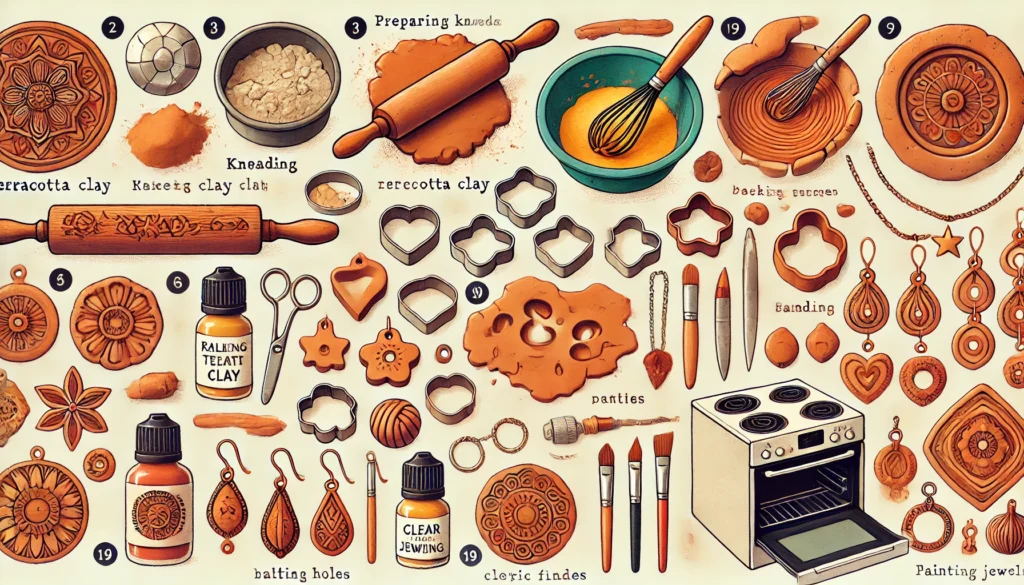
Step 1: Prepare the Clay
To start, take a small amount of terracotta clay and knead it well. Ensure there are no air bubbles, as they can cause cracks during the baking process. The clay should be soft and pliable. If it’s too dry, add a few drops of water and knead again.
Step 2: Roll Out the Clay
Using a rolling pin or clay roller, flatten the clay to your desired thickness—typically around 3 to 5 mm. This thickness ensures that the jewelry pieces are sturdy yet not too heavy to wear.
Step 3: Cut Out Shapes
Use cookie cutters, molds, or a knife to cut out shapes from the rolled-out clay. Popular shapes for terracotta jewelry include circles, squares, leaves, and geometric patterns. If you want to add more intricate designs, use a needle or a carving tool to create patterns on the surface of the clay.
Step 4: Make Holes for Findings
Using a needle or pin, carefully poke holes where you want to attach hooks, chains, or other findings. Ensure the holes are big enough to accommodate your jewelry findings but not too large that they compromise the structure of the clay.
Step 5: Smooth the Edges
Gently smooth the edges of each piece with a damp sponge or your fingers. This will help give a more polished and refined look to the final product. Let the pieces dry for a bit before moving on to the next step.
Step 6: Bake the Clay
Preheat your oven to 220°F (104°C). Place the clay pieces on a baking tray lined with parchment paper and bake for 30-40 minutes. Baking time may vary depending on the size and thickness of your pieces, so keep an eye on them. Once baked, let them cool completely before handling.
Step 7: Sand and Refine
Once the pieces are baked and cooled, use fine-grit sandpaper to smooth out any rough edges or surfaces. This step is crucial for giving your jewelry a professional finish.
Step 8: Paint Your Jewelry
Now comes the fun part—painting! Use acrylic or fabric paints to decorate your jewelry pieces. You can choose traditional designs or contemporary patterns, depending on your style preference. Allow the paint to dry completely.
Step 9: Apply a Varnish
To seal the paint and give the jewelry a shiny finish, apply a layer of clear varnish or glaze. This step also makes the jewelry water-resistant and more durable.
Step 10: Assemble the Jewelry
Attach hooks, chains, and other findings to your jewelry pieces using the holes made earlier. Use pliers to securely attach these findings, ensuring your jewelry is both functional and beautiful.
Step 11: Enjoy Your Handmade Terracotta Jewelry!
Congratulations! You’ve now created your very own terracotta jewelry. Whether it’s a pair of earrings, a necklace, or a bracelet, these handmade pieces are perfect for any occasion and make great gifts too.
Tips for Making Terracotta Jewelry
- Experiment with different shapes, sizes, and colors to create a diverse collection.
- If you’re new to painting, start with simple designs and gradually work your way up to more intricate patterns.
- Always wear a mask when sanding the baked clay to avoid inhaling any dust.
Conclusion
Making terracotta jewelry at home is a fun, creative, and eco-friendly activity that allows you to express your artistic side. With this step-by-step guide and a bit of practice, you’ll be crafting beautiful, unique jewelry pieces in no time!
Discover the unexpected comeback of ancient beadwork and beaded jewelry traditions that are turning heads!
Uncover how ancient beadwork and beaded jewelry traditions are making a vibrant comeback. Learn why these intricate pieces are capturing modern fashion.
Beadwork and beaded jewelry are experiencing a surprising resurgence, with contemporary fashion circles embracing this ancient art form in unexpected ways. Once relegated to traditional attire and cultural events, beadwork is now making bold statements on global runways and modern accessories. This vibrant craft is not just about decoration; it is a reflection of cultural heritage, artistic expression, and sustainable fashion. The revival of beaded jewelry aligns with a broader trend of returning to handcrafted, unique items that tell a story beyond the mass-produced world of fast fashion.
The History and Cultural Significance of Beadwork
Beadwork and beaded jewelry have deep historical roots, tracing back thousands of years across various cultures, from African tribes to Native American communities, and even ancient Egyptian societies. Each bead, whether made from bone, shell, glass, or gemstone, carried meaning and purpose, representing status, spirituality, or cultural identity. Beadwork was not only an artistic endeavor but also a societal marker.
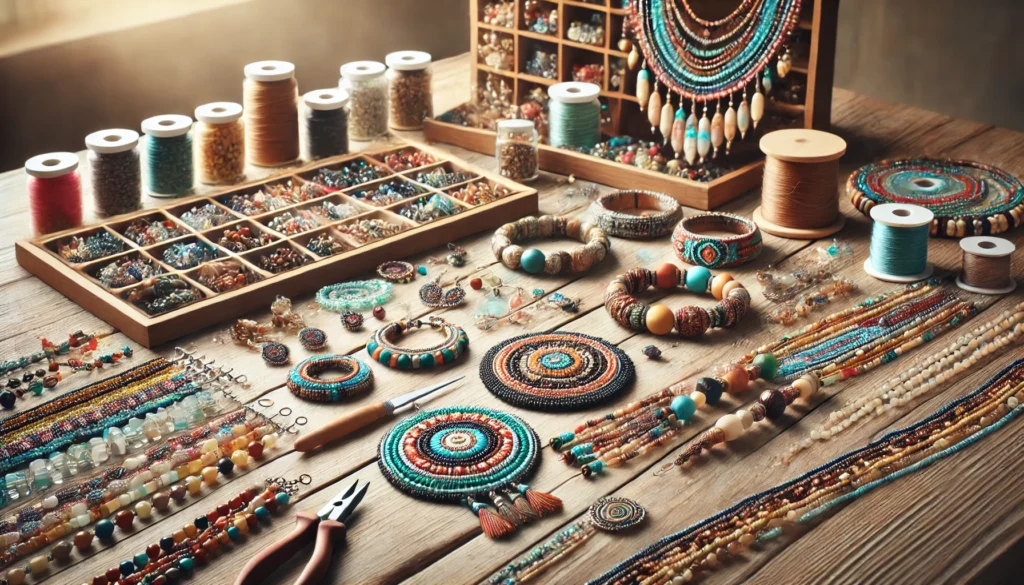
According to historians, beadwork served as a medium of communication and expression, with patterns and colors holding specific meanings. Beadwork expert Carol Wilcox noted that beads have been considered “an essential part of human expression, similar to language or music.” Today, modern artisans are reviving these ancient practices, infusing them with contemporary designs to appeal to today’s fashion enthusiasts.
Beadwork as a Modern Fashion Statement
In recent years, beaded jewelry has evolved beyond its traditional boundaries, finding a place in modern fashion as a statement piece. This transformation has been fueled by a growing appreciation for slow fashion—an approach that values craftsmanship, sustainability, and individuality. Fashion influencers and celebrities have embraced beaded jewelry for its versatility and unique aesthetic, often opting for custom-made pieces that reflect personal style.
The modern resurgence can also be attributed to a desire for more meaningful and ethical fashion choices. Unlike machine-made accessories, each beaded piece requires hours of meticulous handwork, making every piece unique. A recent fashion analyst noted that “the labor-intensive nature of beadwork aligns perfectly with current trends that favor authenticity and artisanal quality over mass-produced uniformity.”
Craftsmanship Meets Innovation: New Trends in Beaded Jewelry
The revival of beadwork is not just about re-creating traditional patterns but also about innovation and new trends. Artisans are experimenting with unconventional materials like recycled glass, sustainable beads, and even 3D-printed beads. The fusion of traditional techniques with modern technology is giving rise to fresh, innovative designs that cater to a broader market.
For example, mixed-media beadwork that combines metal, fabric, and traditional beads is becoming increasingly popular. This trend adds a contemporary twist to the classic beadwork, making it more appealing to younger consumers. Fashion expert Janet Wong observed that “by blending the old with the new, artisans are redefining what beadwork can be, ensuring it stays relevant in an ever-changing fashion landscape.”
The Future of Beadwork in the Global Market
Industry experts believe that beadwork is on track to secure a permanent place in the global market, particularly as consumers become more conscious of sustainability and the stories behind their purchases. The craft’s adaptability to modern tastes, coupled with its rich cultural heritage, gives it a unique edge.
Moreover, with the rise of online marketplaces like Etsy and Amazon Handmade, artisans from around the world now have a platform to showcase their unique creations to a global audience. As a result, there has been an increase in demand for authentic, handcrafted beaded jewelry, which not only supports local artisans but also promotes cultural heritage.
Jewelry designer Alicia Miller stated, “The value of beadwork lies not just in its beauty, but in its ability to connect the wearer to a rich tapestry of history and culture.” With the right balance of innovation and tradition, the future of beadwork appears bright and promising.
A Craft that Transcends Time
The resurgence of beadwork and beaded jewelry is more than just a fashion trend—it is a movement towards embracing heritage, sustainability, and craftsmanship in a modern context. As artisans continue to innovate while preserving ancient techniques, beadwork is set to remain a vibrant and cherished part of the global fashion scene.
Why textile and fabric-based jewelry is the hottest new trend in sustainable fashion!
Discover how textile and fabric-based jewelry is revolutionizing sustainable fashion. Learn how these unique pieces are crafted and their growing appeal.
Textile and fabric-based jewelry is redefining sustainable fashion, bringing creativity, innovation, and eco-consciousness together in an unexpected and captivating way. Moving beyond traditional metal and gemstone options, artisans are turning to soft materials like cotton, jute, felt, and recycled fabrics to create stunning, lightweight jewelry that is both stylish and sustainable. With a growing emphasis on environmental responsibility in the fashion industry, fabric-based jewelry is emerging as a unique and ethical alternative, appealing to a diverse audience seeking distinctive fashion statements.
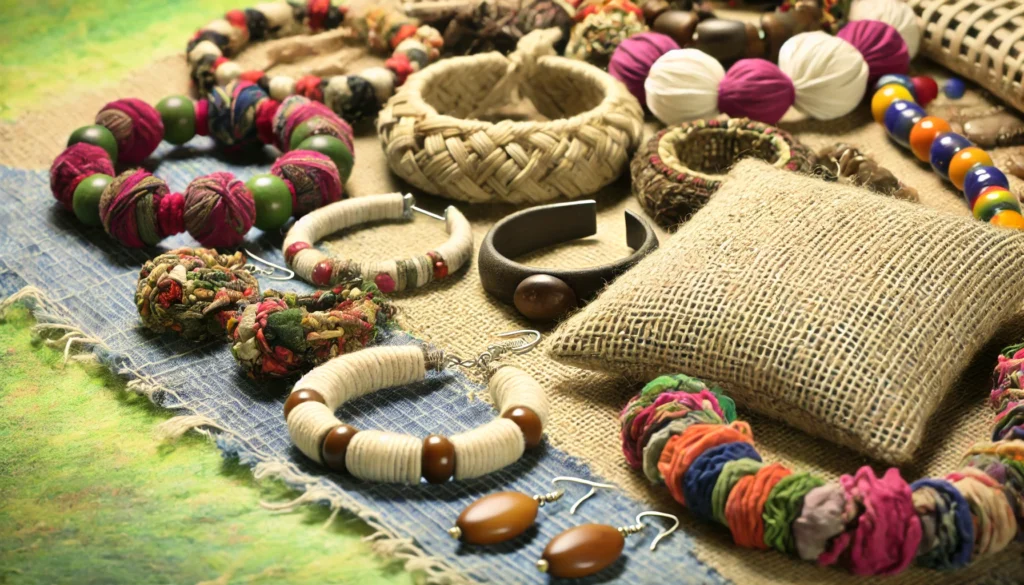
The Emergence of Textile and Fabric-Based Jewelry
The concept of textile and fabric-based jewelry is not entirely new; it draws inspiration from age-old practices where communities around the world used natural fibers and textiles to adorn themselves. However, in recent years, this type of jewelry has gained significant traction in mainstream fashion circles, thanks to the push for sustainability and ethical fashion. According to fashion historian Anita Patel, “fabric-based jewelry represents a shift towards valuing materials that are renewable, biodegradable, and have a lower carbon footprint.”
The versatility of textile jewelry is another reason for its rising popularity. From statement necklaces made of braided cotton to intricately woven jute earrings and patchwork fabric cuffs, these pieces offer endless design possibilities. The use of vibrant colors, unique textures, and innovative weaving techniques allows designers to craft accessories that are not only visually appealing but also rich in cultural significance.
How Textile and Fabric-Based Jewelry is Crafted
Creating fabric-based jewelry involves a blend of traditional craftsmanship and modern design techniques. Many artisans start by selecting high-quality, sustainable fabrics—such as organic cotton, hemp, silk, or even repurposed materials like denim or sari fabrics. These textiles are then cut, shaped, and treated to create various jewelry elements. Techniques like braiding, knotting, stitching, and embroidery are commonly used to give the pieces form and structure.
Textile jewelry often incorporates other sustainable materials such as wood, shells, or seeds to add depth and dimension. Designers might also use natural dyes and eco-friendly adhesives to ensure the final product is entirely sustainable. Jewelry designer and environmental advocate Sasha Morgan pointed out that “every step in the creation process of fabric-based jewelry, from material selection to finishing touches, is an opportunity to make a more sustainable choice.”
The Growing Appeal of Sustainable Jewelry
The demand for textile and fabric-based jewelry is driven by a growing desire for sustainable fashion. Today’s consumers are increasingly concerned about the environmental impact of their purchases and are opting for products that align with their values. Fabric-based jewelry fits perfectly within this mindset, offering a stylish yet conscious alternative to traditional jewelry.
Another key appeal of textile jewelry is its comfort and lightweight nature. Unlike heavy metal pieces, fabric-based jewelry can be worn for extended periods without discomfort. This quality makes it particularly popular for summer wear and casual styling, where comfort and style go hand-in-hand. Moreover, the customizable nature of textile jewelry means that pieces can be tailored to suit specific tastes or complement particular outfits, adding a unique touch to any wardrobe.
The Future of Fabric-Based Jewelry
Fashion industry experts believe that fabric-based jewelry has significant growth potential, especially as more consumers and brands embrace sustainable practices. The trend is also gaining momentum thanks to increased visibility on social media and e-commerce platforms, where independent artisans and small-scale designers showcase their creations to a global audience.
Ethical fashion consultant Monica Vance noted that “textile jewelry represents a convergence of art, culture, and sustainability—three elements that modern consumers find increasingly attractive.” She also emphasized that as fashion continues to evolve toward more sustainable practices, fabric-based jewelry will likely become a staple in the accessory market.
A New Era of Fashion Accessories
Textile and fabric-based jewelry is more than just a trend; it is a reflection of the changing values in fashion. As more people seek accessories that are not only beautiful but also ethical and sustainable, the appeal of fabric-based jewelry will continue to grow. With a focus on craftsmanship, innovation, and environmental responsibility, this unique form of jewelry is set to make a lasting impact on the fashion world.
How embroidery and thread art are redefining jewelry – the stunning transformation you need to see!
Explore how embroidery and thread art are being reimagined in jewelry design, combining tradition with innovation. Discover this evolving trend now.
Embroidery and thread art are experiencing a renaissance in the world of jewelry design, where traditional needlework techniques are being reimagined to create intricate and elegant accessories. From embroidered pendants to thread-wrapped earrings and intricate Aari-work bracelets, these handmade pieces blend the timeless charm of needle and thread with contemporary fashion sensibilities. As fashion trends lean towards authenticity, sustainability, and personalization, embroidery and thread art jewelry are becoming a favorite among those seeking unique and meaningful adornments.
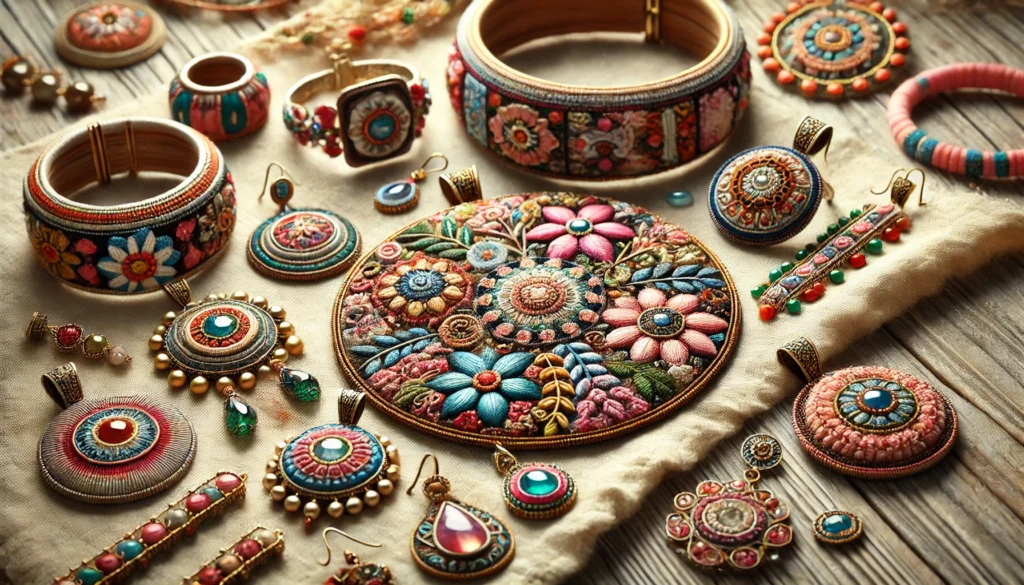
The Resurgence of Embroidery and Thread Art in Jewelry
Historically, embroidery has been a part of textile embellishment for centuries, with different styles and techniques emerging across various cultures. However, incorporating these intricate designs into jewelry is a more recent phenomenon that has caught the eye of modern fashion designers and enthusiasts. The shift is driven by a growing appreciation for handcraftsmanship, sustainable practices, and the desire for accessories that tell a story. Art historian Megan Searle emphasized that “embroidery and thread art are more than just decorative crafts; they are a means of storytelling, reflecting cultural heritage and personal narratives.”
As consumers move away from mass-produced items, the demand for handmade, embroidered jewelry has surged. These pieces often feature a blend of traditional techniques such as zardozi, Kantha, or Aari work, with modern designs that cater to contemporary tastes. The result is a range of unique jewelry that is both rich in heritage and aligned with current fashion trends.
How Embroidery and Thread Art Jewelry is Made
Creating embroidery and thread art jewelry involves a detailed and labor-intensive process. Artisans use various stitches, from the simple backstitch to the more intricate bullion knot, to form patterns and motifs on fabric bases. These embroidered pieces are then incorporated into jewelry settings such as metal frames for pendants or earrings. Thread-wrapped bangles and rings are another popular style, where colorful threads are meticulously wrapped around a base to create vibrant, textured jewelry.
A unique aspect of embroidered jewelry is its versatility. Designers can use different materials—such as silk, cotton, or metallic threads—and incorporate beads, sequins, and gemstones to add depth and dimension. Fashion designer Rachel Tan remarked that “the beauty of embroidery lies in its adaptability; it can be as minimalist or as extravagant as one desires.”
The Growing Popularity of Embroidered Jewelry
The appeal of embroidery and thread art jewelry lies in its ability to blend traditional craftsmanship with modern design sensibilities. Many consumers are drawn to these pieces because they represent a fusion of history and innovation. Each piece of embroidered jewelry is one-of-a-kind, reflecting the artist’s skill and creativity. This uniqueness is particularly appealing in a market saturated with generic accessories.
Moreover, embroidered jewelry often aligns with the principles of slow fashion. It takes time, skill, and patience to produce each piece, which contrasts sharply with the mass production typical of the fast fashion industry. Consumers who value sustainability and ethical production practices are increasingly choosing embroidered jewelry for this reason. Jewelry market analyst Karen Zhao noted that “handcrafted embroidery in jewelry is a powerful statement against the disposable nature of modern fashion.”
The Future of Embroidery in Jewelry Design
Experts believe that embroidery and thread art will continue to thrive in jewelry design, especially as the trend toward personalized and meaningful fashion grows stronger. The craft’s adaptability allows it to evolve with changing fashion trends, ensuring its relevance in the future. Additionally, as more designers and consumers recognize the value of handcrafted, sustainable accessories, embroidered jewelry is poised to occupy a significant space in the fashion market.
Fashion trend analyst Isabella King highlighted that “embroidered jewelry is not just a trend but a testament to the timeless elegance of needlework. It bridges the gap between the past and the present, making it a versatile choice for fashion-forward consumers.”
A Timeless Craft with a Modern Twist
Embroidery and thread art have successfully transcended their traditional roots to become a significant trend in jewelry design. By combining age-old techniques with contemporary styles, artisans are crafting pieces that are as unique as they are meaningful. As the fashion industry continues to embrace sustainability and authenticity, embroidery and thread art jewelry will likely remain a cherished choice for those who appreciate the beauty of handmade craftsmanship.
Macramé is back! Discover how ancient knotting techniques are transforming jewelry trends!
Explore the revival of macramé and knotting techniques in modern jewelry, blending ancient crafts with contemporary styles. Learn more about this trending art form.
Macramé and knotting techniques are experiencing a remarkable revival in the world of jewelry design, captivating fashion enthusiasts and artisans alike with their intricate patterns and bohemian charm. Rooted in ancient crafting traditions, these techniques involve the art of tying knots to create beautiful, textured designs that can be adapted into various jewelry pieces, from earrings and bracelets to necklaces and anklets. As fashion trends continue to embrace artisanal craftsmanship and sustainability, macramé jewelry is becoming a standout choice for those seeking unique, handmade accessories.
The Historical Significance of Macramé and Knotting in Craft
Macramé, a craft that dates back centuries, is believed to have originated with 13th-century Arab weavers who used knotting techniques to create decorative fringes on textiles. The art form spread throughout Europe, where it became popular among sailors who used it to pass the time while at sea. By the Victorian era, macramé became a fashionable home decor trend, often used to create intricate wall hangings and plant holders.
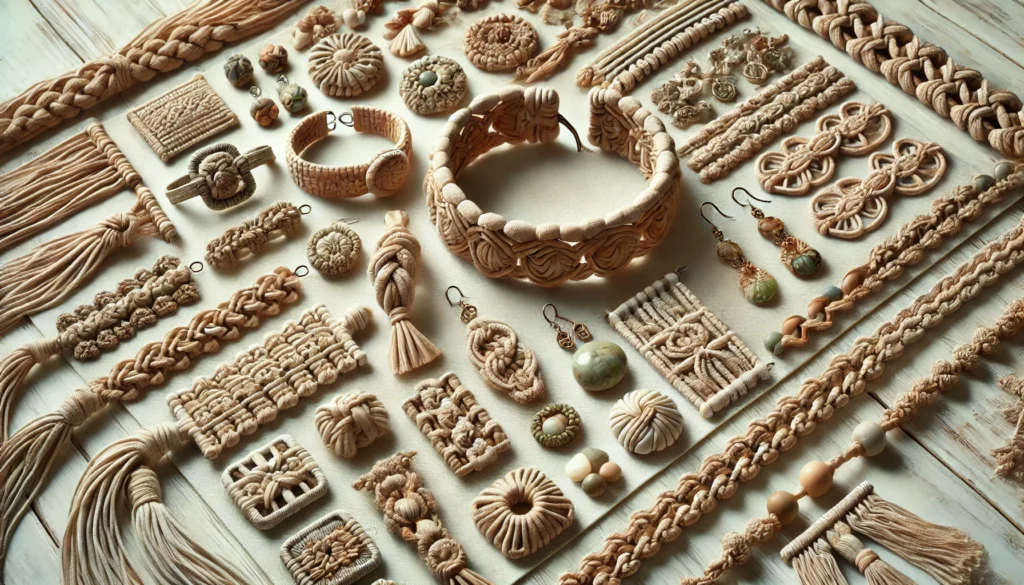
In jewelry design, macramé and other knotting techniques bring a rich history of craftsmanship to contemporary fashion. Fashion historian Mark Jensen stated that “macramé is more than just a decorative art; it’s a versatile craft that speaks to the history of human creativity.” Today, artisans are reviving these ancient techniques to create modern, stylish jewelry that appeals to a wide range of tastes.
How Macramé Jewelry is Crafted
Creating macramé jewelry involves a meticulous process that requires patience, skill, and an eye for detail. Artisans use various knotting techniques, such as the square knot, half-hitch knot, and lark’s head knot, to create intricate patterns and textures. The jewelry pieces are often made from materials like cotton, hemp, linen, or waxed cords, which provide both durability and a natural, earthy aesthetic.
Macramé jewelry can be adorned with beads, shells, or semi-precious stones to add a touch of elegance and uniqueness. The process typically begins with designing a pattern and measuring out cords of varying lengths. The artisan then carefully ties knots to create the desired design, adjusting the tension and spacing to ensure uniformity. Jewelry designer Elisa Ramos mentioned that “macramé offers a tactile experience—each knot is carefully tied, making every piece of jewelry unique and personal.”
The Growing Popularity of Macramé Jewelry in Modern Fashion
The resurgence of macramé and knotting techniques in jewelry can be attributed to several factors, including the rise of bohemian fashion, a renewed interest in handcrafted accessories, and the emphasis on sustainable, slow fashion. Unlike mass-produced jewelry, each piece of macramé jewelry is handmade, making it inherently more sustainable and environmentally friendly.
The aesthetic appeal of macramé jewelry also plays a significant role in its popularity. The textured patterns and natural materials give macramé jewelry a unique, earthy vibe that pairs well with various styles, from casual, everyday wear to more elaborate, boho-chic looks. Fashion influencer Claire Donovan noted that “macramé jewelry has a timeless appeal; it’s both rustic and refined, making it perfect for those who love to mix and match styles.”
The Future of Macramé and Knotting Techniques in Jewelry Design
Experts believe that macramé and knotting techniques will continue to thrive in the jewelry industry, especially as consumers increasingly prioritize sustainability and artisanal quality. The craft’s adaptability allows for a wide range of designs, from minimalist pieces to bold statement jewelry, ensuring its relevance in the ever-evolving fashion landscape.
Craft industry expert Julia Harmon emphasized that “macramé is more than just a trend—it’s a celebration of craftsmanship and creativity. As more people seek out unique, handmade jewelry that tells a story, macramé will continue to grow in popularity.” She added that with the rise of online platforms like Etsy and Instagram, artisans now have more opportunities to showcase their macramé jewelry to a global audience, further fueling the trend.
A Timeless Craft with Modern Appeal
Macramé and knotting techniques are proving that ancient crafts can find new life in modern jewelry design. As artisans continue to innovate and explore the possibilities of these versatile techniques, macramé jewelry will remain a popular choice for those who appreciate the beauty of handmade, sustainable accessories. With its blend of history, artistry, and contemporary style, macramé is truly a craft for the ages.
Upcycled jewelry is taking over fashion – and here’s why you need to be a part of it!
Explore the growing trend of textile crafts and upcycled jewelry that blends sustainability with creativity. Learn how these unique pieces are reshaping fashion.
Textile crafts and upcycled jewelry are making waves in the fashion world, redefining sustainability with creativity and style. In a time when environmental consciousness is paramount, more consumers and designers are turning to upcycled jewelry crafted from recycled fabrics, old clothing, and discarded materials. This trend is not only eco-friendly but also offers a fresh take on fashion accessories, where each piece carries a story and a purpose. By merging traditional textile crafts with modern upcycling techniques, designers are creating unique jewelry that appeals to those who want to make a fashion statement with minimal environmental impact.
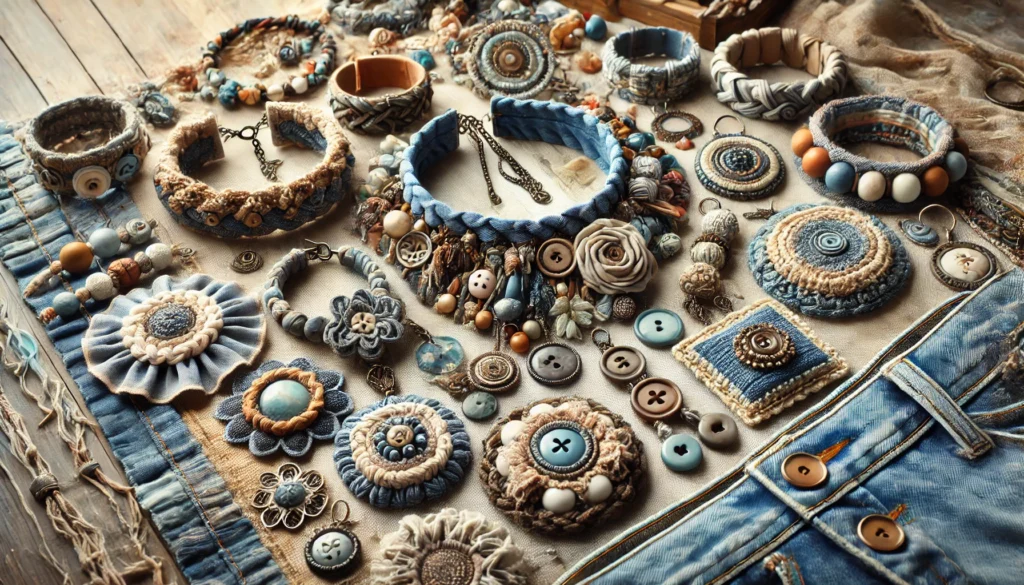
The Rise of Upcycled Jewelry in Sustainable Fashion
The concept of upcycled jewelry is gaining popularity as part of a broader movement toward sustainable fashion. Unlike traditional recycling, upcycling involves repurposing materials into new products with higher quality or artistic value. This approach allows designers to transform old fabrics, scraps, and discarded clothing into one-of-a-kind jewelry pieces that are both stylish and environmentally friendly. The use of textile crafts such as weaving, knitting, and crochet adds a rich, handmade touch to these pieces.
Fashion sustainability advocate Jenna Meyer noted that “upcycled jewelry is a revolutionary step in sustainable fashion. It’s about reimagining waste as a resource and creating something beautiful and meaningful out of it.” This philosophy resonates strongly with consumers who are becoming increasingly mindful of the environmental impact of their purchases.
How Upcycled Jewelry is Crafted
Creating upcycled jewelry from textiles and other materials involves a thoughtful and creative process. Designers begin by sourcing materials, such as fabric scraps, old denim, leather offcuts, or vintage lace, often collecting these from thrift stores, garment factories, or even their own closets. The next step involves deconstructing these materials and reimagining them into new forms. Techniques like weaving, braiding, sewing, and embroidery are commonly used to transform these discarded textiles into wearable art.
For example, an upcycled denim necklace might start with strips of old jeans braided together and adorned with beads or metal charms. A pair of earrings could be crafted from vintage lace, stiffened with eco-friendly solutions, and embellished with repurposed buttons or broken jewelry pieces. Jewelry designer Lara Thompson explained that “upcycling allows for an immense amount of creativity. Each piece is a challenge to see the potential in something discarded.”
The Growing Popularity of Upcycled Jewelry
Upcycled jewelry is gaining traction for several reasons. First, it aligns with the principles of sustainable fashion by reducing waste and minimizing the demand for new raw materials. This eco-friendly approach not only helps the environment but also encourages a shift away from the fast fashion model, which is notorious for its negative impact on the planet.
Second, upcycled jewelry offers a sense of uniqueness and exclusivity. Each piece is handmade and one-of-a-kind, providing consumers with a personal connection to their accessories. This individuality stands in stark contrast to mass-produced jewelry, where uniformity is the norm. Fashion influencer and sustainability advocate Mia Chen observed that “upcycled jewelry is for those who want to stand out and support ethical fashion. It tells a story that mass-produced items simply cannot.”
The Future of Textile Crafts and Upcycled Jewelry
Experts believe that upcycled jewelry will continue to grow in popularity as more consumers seek sustainable and ethically produced fashion. The versatility of textile crafts combined with the creativity of upcycling provides endless possibilities for innovation. Moreover, as the fashion industry grapples with the need for sustainable practices, upcycled jewelry is positioned as a forward-thinking solution.
Sustainable fashion consultant Nadia Patel stated that “upcycled jewelry is not just a trend; it’s a necessary evolution in the fashion industry. It challenges the traditional fashion cycle and introduces a new way of thinking about waste and design.” With more designers embracing upcycling and consumers supporting these initiatives, the future of textile crafts and upcycled jewelry looks promising.
Fashion with Purpose and Innovation
Textile crafts and upcycled jewelry represent a powerful fusion of sustainability and creativity, offering a fresh perspective on what fashion accessories can be. As the movement toward eco-conscious fashion grows stronger, upcycled jewelry will continue to shine as a meaningful and stylish alternative to traditional jewelry. For those looking to make a fashion statement that is both beautiful and impactful, upcycled jewelry provides the perfect opportunity.
The online boom in handmade jewelry sales – find out how e-commerce is changing the game!
Discover how online craft marketplaces and e-commerce are transforming the handmade jewelry industry, making unique designs accessible to a global audience.
Online craft marketplaces and e-commerce platforms are revolutionizing the way handmade jewelry is bought and sold, connecting artisans with a global audience like never before. Gone are the days when handmade jewelry was limited to local markets and craft fairs; today, thanks to the rise of digital platforms, artisans can showcase their unique creations to customers around the world with just a few clicks. This digital shift has not only expanded market access but also empowered independent designers to thrive in an increasingly competitive industry. As e-commerce continues to grow, it is reshaping the landscape of handmade jewelry, bringing creativity and craftsmanship to the forefront of global fashion.
The Growth of Online Craft Marketplaces
The emergence of online craft marketplaces such as Etsy, Amazon Handmade, and eBay has been a game-changer for the handmade jewelry industry. These platforms provide a dedicated space for artisans to list their products, reach a wider audience, and build their brands. Unlike traditional retail, which often requires significant overhead and inventory management, online marketplaces offer a more accessible entry point for independent designers. This democratization of retail has led to an explosion of creativity, with countless unique jewelry pieces now available to consumers worldwide.
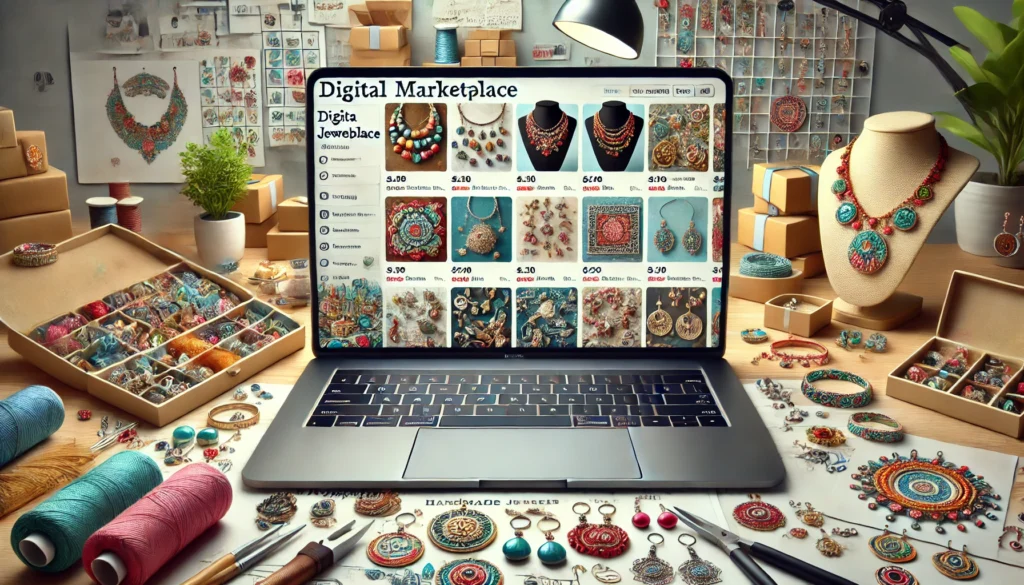
Artisan jewelry maker Sarah Bennett remarked that “online marketplaces have given small designers like me the opportunity to compete with big brands. It’s not just about selling jewelry; it’s about telling my story and connecting with customers who appreciate the artistry.” This direct connection between artisans and customers is one of the key strengths of online craft marketplaces.
The Role of E-Commerce in Expanding Market Reach
E-commerce has further amplified the reach of handmade jewelry by breaking down geographical barriers and making it easier for customers to discover and purchase products from around the globe. With the click of a button, shoppers can browse a vast array of handmade jewelry, read reviews, and make informed purchasing decisions—all from the comfort of their homes. This convenience has fueled the growth of e-commerce in the handmade sector, particularly during the COVID-19 pandemic when physical shopping was restricted.
Additionally, the integration of social media with e-commerce has opened new avenues for marketing and sales. Platforms like Instagram and Pinterest have become powerful tools for showcasing jewelry, with influencers and artisans alike using these platforms to drive traffic to their online stores. Jewelry marketing expert Emily Rogers noted that “social media has transformed the way jewelry is marketed. It’s about creating a visual story that resonates with people, leading them to explore and purchase directly from online stores.”
Challenges and Opportunities in the Digital Marketplace
While the rise of online craft marketplaces and e-commerce has created significant opportunities for handmade jewelry artisans, it also comes with challenges. The increased competition in the digital space means that standing out requires more than just great products; it demands effective branding, SEO optimization, and customer engagement. Artisans must navigate the complexities of digital marketing, from search engine algorithms to social media strategies, to ensure their products are visible and appealing to potential customers.
However, the opportunities far outweigh the challenges. E-commerce allows for a level of flexibility and scalability that traditional retail cannot match. Artisans can experiment with different product lines, test new designs, and gather immediate feedback from customers. This agility is particularly valuable in the fast-paced world of fashion, where trends can change quickly. Market analyst Jessica Stone commented that “the digital marketplace is a dynamic environment that rewards innovation. Artisans who can adapt and leverage the tools available will find success in this space.”
The Future of Handmade Jewelry in E-Commerce
Experts predict that the e-commerce market for handmade jewelry will continue to grow as more consumers seek out unique, artisanal products. The convenience of online shopping, combined with the desire for personalized and meaningful jewelry, will drive this trend forward. Additionally, advancements in technology, such as augmented reality and AI-driven recommendations, are expected to enhance the online shopping experience, making it even easier for customers to find and purchase handmade jewelry.
E-commerce strategist Laura Davis emphasized that “the future of handmade jewelry is online. As technology continues to evolve, we’ll see even more innovative ways for artisans to connect with customers and showcase their work.” She added that the key to success in this space will be a combination of creativity, adaptability, and a strong online presence.
A New Era for Handmade Jewelry Sales
The rise of online craft marketplaces and e-commerce has ushered in a new era for the handmade jewelry industry, offering artisans unprecedented opportunities to reach a global audience. As the digital marketplace continues to evolve, those who embrace the power of e-commerce will thrive, bringing their unique creations to customers worldwide. With the right strategies and tools, the future of handmade jewelry sales looks brighter—and more accessible—than ever.
